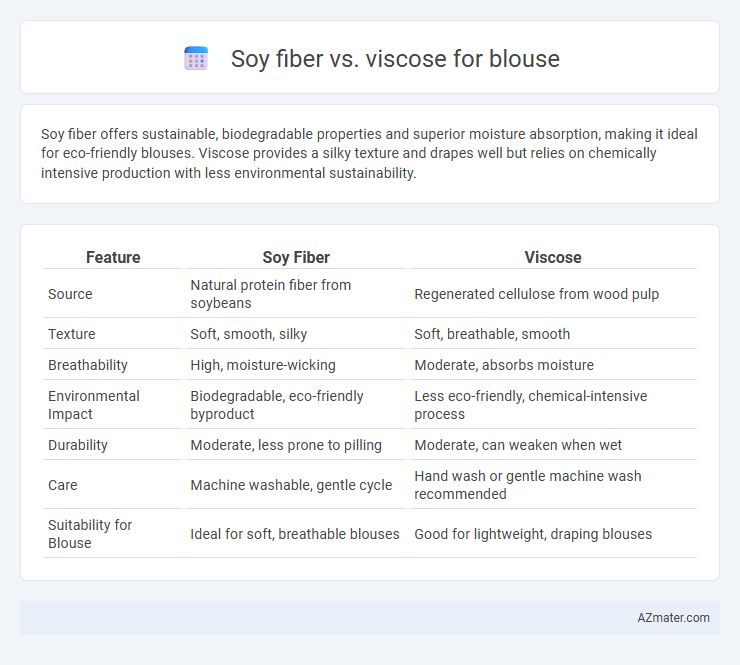Soy fiber offers sustainable, biodegradable properties and superior moisture absorption, making it ideal for eco-friendly blouses. Viscose provides a silky texture and drapes well but relies on chemically intensive production with less environmental sustainability.
Table of Comparison
| Feature | Soy Fiber | Viscose |
|---|---|---|
| Source | Natural protein fiber from soybeans | Regenerated cellulose from wood pulp |
| Texture | Soft, smooth, silky | Soft, breathable, smooth |
| Breathability | High, moisture-wicking | Moderate, absorbs moisture |
| Environmental Impact | Biodegradable, eco-friendly byproduct | Less eco-friendly, chemical-intensive process |
| Durability | Moderate, less prone to pilling | Moderate, can weaken when wet |
| Care | Machine washable, gentle cycle | Hand wash or gentle machine wash recommended |
| Suitability for Blouse | Ideal for soft, breathable blouses | Good for lightweight, draping blouses |
Introduction to Soy Fiber and Viscose
Soy fiber, a sustainable textile derived from soybean protein, offers a soft texture and excellent moisture absorption, making it ideal for lightweight blouses. Viscose, a semi-synthetic fiber produced from wood pulp, provides a silky feel and drapes well, commonly used in fashion garments for its smooth finish. Both fibers are popular in blouse manufacturing, with soy fiber favored for eco-friendliness and viscose for its luxurious appearance.
Origins and Production Processes
Soy fiber, derived from soybean protein through a process of extracting, crushing, and spinning, offers a sustainable alternative to traditional fibers with natural moisture-wicking and softness properties. Viscose is produced from cellulose extracted from wood pulp, chemically treated and regenerated into fibers, involving a more intensive process with harsher chemicals compared to soy fiber. The origins of soy fiber from renewable agricultural byproducts contrast with viscose's dependence on forestry resources, impacting their environmental footprint and suitability for eco-friendly blouse production.
Environmental Impact Comparison
Soy fiber, derived from soybean protein, offers a biodegradable and renewable alternative with lower water consumption and fewer chemical treatments compared to viscose, which is produced from wood pulp and involves energy-intensive processes including toxic chemicals like carbon disulfide. The environmental impact of soy fiber includes reduced greenhouse gas emissions and less deforestation, while viscose production contributes significantly to habitat loss and water pollution. Choosing soy fiber for blouses supports sustainable agriculture practices and minimizes ecological footprints, making it a greener choice over viscose in eco-conscious fashion.
Fabric Texture and Feel
Soy fiber offers a smooth, silk-like texture with a natural sheen, providing a soft and breathable feel ideal for blouses. Viscose features a silky, lightweight fabric with excellent drape, delivering a cool and smooth touch against the skin. Compared to viscose, soy fiber tends to retain more moisture and feels warmer, making it suitable for comfortable, elevated blouse designs.
Durability and Longevity
Soy fiber offers superior durability compared to viscose, as it retains strength after multiple washes and resists pilling and tearing. Viscose, while soft and breathable, tends to degrade faster due to its cellulose-based composition, resulting in shorter garment lifespan. Blouses made from soy fiber provide longer-lasting wear and maintain their structural integrity better over time.
Moisture Absorption and Breathability
Soy fiber offers superior moisture absorption and breathability compared to viscose, making it an excellent choice for blouses worn in warm or humid conditions. Its natural protein-based structure allows it to wick moisture away from the skin, promoting faster evaporation and keeping the wearer cool and dry. Viscose, while breathable, tends to retain more moisture, which can result in a less comfortable wearing experience during prolonged heat exposure.
Color Retention and Dyeing Properties
Soy fiber exhibits superior color retention and dyeing properties compared to viscose, maintaining vibrant hues after multiple washes due to its natural protein structure that bonds effectively with dyes. Viscose tends to fade faster because its cellulose-based composition absorbs dye unevenly and is more prone to color loss with laundering and sunlight exposure. The better affinity of soy fiber to both reactive and acid dyes results in richer, longer-lasting colors, making it ideal for blouses requiring durability in color vibrancy.
Allergy and Skin Friendliness
Soy fiber is a natural, hypoallergenic material known for its moisture-wicking and breathable properties, making it highly suitable for sensitive skin and allergy sufferers. Viscose, derived from wood pulp, can sometimes cause irritation due to chemical processing residues, which may trigger allergies in delicate or reactive skin types. Choosing soy fiber blouses reduces the risk of allergic reactions and enhances skin comfort compared to viscose alternatives.
Style Versatility for Blouses
Soy fiber offers a natural sheen and soft drape that enhances the style versatility of blouses, making them suitable for both casual and formal wear. Viscose provides a smooth, lightweight texture with excellent breathability, allowing for varied blouse designs from flowy to structured fits. Both fibers blend comfort with elegance, but soy fiber's eco-friendly appeal adds a modern, sustainable edge to versatile blouse styles.
Price and Market Availability
Soy fiber offers a sustainable and often higher-priced alternative to viscose for blouses, reflecting its niche market status and eco-friendly appeal. Viscose remains widely available and cost-effective, dominating the market due to cheaper production methods and extensive supply chains. Consumers seeking affordability and easy access typically prefer viscose, while those valuing sustainable textiles may opt for soy fiber despite its premium price point.

Infographic: Soy fiber vs Viscose for Blouse
 azmater.com
azmater.com